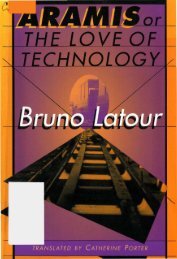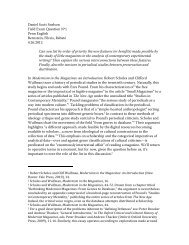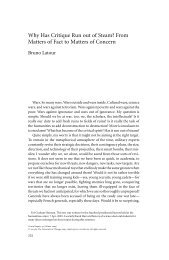The Exploit: A Theory of Networks - asounder
The Exploit: A Theory of Networks - asounder
The Exploit: A Theory of Networks - asounder
Create successful ePaper yourself
Turn your PDF publications into a flip-book with our unique Google optimized e-Paper software.
Edges 107<br />
In these visions <strong>of</strong> health care—in which the law <strong>of</strong> large numbers<br />
is the content, and network topology is the form—there are<br />
also many questions raised. <strong>The</strong> sociologist Michael Fortun, in his<br />
study <strong>of</strong> population genome projects, wonders if we have moved from<br />
classical medicine’s care <strong>of</strong> the body <strong>of</strong> the patient (what Foucault referred<br />
to as a “care <strong>of</strong> the self”) to a more post - Fordist “care <strong>of</strong> the<br />
data,” in which the job <strong>of</strong> public health is increasingly to ensure that<br />
the biological bodies <strong>of</strong> the population correlate to the informatic<br />
patterns on the screen. 1<br />
<strong>The</strong> “epidemic” exhibits such as Biennale.py and the Global Health<br />
Odyssey are <strong>of</strong> interest because they are not simply exhibits that happen<br />
to have biological motifs. As different as they are, they put curating<br />
and curing into a relationship. It is a relationship mediated by<br />
curare or care. But what is “care” in this case? It is a type <strong>of</strong> care that<br />
is far from the humanistic and phenomenological notion <strong>of</strong> person -<br />
to - person care; it is a “care <strong>of</strong> the data” in which the life <strong>of</strong> information<br />
or “vital statistics” plays a central role.<br />
<strong>The</strong> Datum <strong>of</strong> Cura II<br />
Return to our imagined exhibitions <strong>of</strong> viruses and epidemics. What is<br />
the temporality specific to the practice <strong>of</strong> curating? <strong>The</strong> idea <strong>of</strong> curare<br />
(care) in curating and the activity <strong>of</strong> the curator plays a dual<br />
role. One the one hand, the care in curating conceptually tends toward<br />
the presentation <strong>of</strong> the static: collecting, archiving, cataloging,<br />
and preserving in a context that is both institutional and architectural.<br />
<strong>The</strong>re is a stillness to this (despite the milling about <strong>of</strong> people<br />
in a museum or the awkwardness <strong>of</strong> an “interactive” exhibit). <strong>The</strong><br />
care <strong>of</strong> stillness, within walls, behind glass, is a historical stillness. It is<br />
a stillness <strong>of</strong> the past. But there is also always an excess in curating,<br />
an opening, however wide or narrow, through which the unexpected<br />
happens. As a visitor to an exhibit, one’s interpretations and opinions<br />
might vary widely from both the curator’s original vision and from<br />
the interpretations and opinions <strong>of</strong> other visitors. Or one might not<br />
notice them at all, passing over all the care put into curating. Such is<br />
the scene: there is either too much (“what’s your opinion?”) or too<br />
little (“I didn’t notice”).









